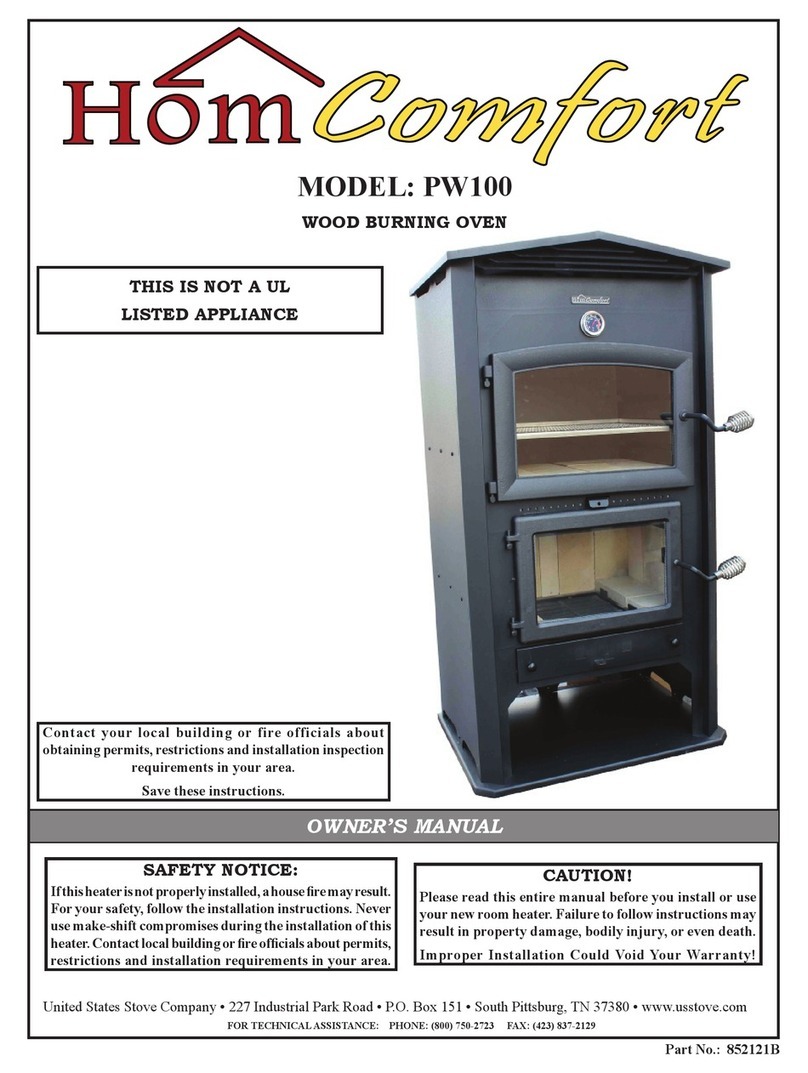
3
IMPORTANT: Read this entire manual before installing and
operating this product. Failure to do so may result in property
damage, bodily injury, or even death. Proper installation of
this oven is crucial for safe and efficient operation.
Install vent at clearances specified by the vent manufacturer.
Do not connect the vent to a vent serving any other appliance.
Do not install a flue damper in the exhaust venting system
of this unit.
Contact your local building officials to obtain a permit and
information on any additional installation restrictions or
inspection requirements in your area.
Do not throw this manual away. This manual has important
operating and maintenance instructions that you will need at
a later time. Always follow the instructions in this manual.
This appliance is designed for the use of solid-wood fuel. The
use of other fuels will void warranty.
Never use gasoline, gasoline-type lantern fuel, kerosene,
charcoal lighter fluid, or similar liquids to start or ‘freshen
up’ a fire in this oven. Keep all such liquids well away from
the oven while it is in use.
A working smoke detector must be installed in the same room
as this product.
Your oven requires periodic maintenance and cleaning (see
“MAINTENANCE ”). Failure to maintain your oven may
lead to improper and/or unsafe operation.
Never try to repair or replace any part of the oven unless
instructions for doing so are given in this manual. All other
work should be done by a trained technician.
Do not operate your oven with the fuel feed door open. Under
these circumstances a safety concern may arise from sparks
or fumes entering the room.
Allow the oven to cool before performing any maintenance
or cleaning.
Disposal of ashes - Ashes must be disposed in a metal
container with a tight fitting lid. The closed container of
ashes should be placed on a non-combustible surface or on the
ground, well away from all combustible materials, pending
final disposal.
The exhaust system should be checked monthly for any build-
up of soot or creosote.
Do not touch the hot surfaces of the oven. Educate all children
on the dangers of a high-temperature oven. Young children
should be supervised when they are in the same room as the
oven.
The oven will be hot during operation; therefore, you should
always use some type of hand protection when refueling your
oven.
Never block free airflow through the open vents of the unit.
Do not place clothing or other flammable items on or near
this oven.
This appliance is not intended for commercial use.
Warning: Operate your oven only on a noncombustible floor
or provide flooring protection adequate to provide ember
protection around our oven.
SAFETY PRECAUTIONS
Creosote-Formation and need for removal. When wood is
burned slowly it produces tar and other organic vapors that
combine with expelled moisture to form creosote. The creosote
vapors condense in a relatively cool flue of a slow burning fire.
As a result, creosote residue accumulates on the flue lining.
When ignited, this creosote makes an extremely hot fire.
When grease or creosote have accumulated, it should be
removed to reduce the risk of fire.
Do not use accessories not specified for use with this appliance.
Verify that the oven is properly installed before firing the oven
for the first time.After reading these instructions, if you have any
doubt about your ability to complete your installation properly,
you must obtain the services of a professional licensed installer
familiar with all aspects of safe and correct installation. DO NOT
use temporary or makeshift compromised during installation.
There must be NO DEVIATION ORALTERATION OFANY
KIND from the very specific instructions spelled out in this
instruction manual as it pertains to the installation of this wood
oven. NO EXCEPTIONS.
DO NOT ELEVATE THE OVEN BY ANY MEANS (i.e.
bricks under legs, cement blocks). Oven must set directly
upon the solid-surface non-combustible floor as specified in
this manual.
DO NOT MODIFY THIS OVEN IN ANY WAY! Assemble
only with original parts as supplied and shown in this manual.
DO NOT OPERATE AN OVEN THAT IS MISSING
PARTS! If any parts are missing or defective, please notify the
dealer or manufacturer immediately. Replace missing, broken,
or worn parts with factory original or equivalent parts only.
Do not connect a wood burning appliance to an aluminum type B
gas vent. This is not safe. Use approved masonry or a UL listed
UL 103HT / ULC-S629 Residential Type and Building Heating
Appliance chimney. Use a 6”/152mm diameter chimney, that
is high enough to give a good draft. (See specifications in the
VENTILATION section).
Follow these guidelines to prevent this colorless, odorless
gas from poisoning you, your family or others.
Know the symptoms of carbon monoxide poisoning: headache,
dizziness, weakness, nausea, vomiting, sleepiness, and
confusion. Carbon monoxide reduces the blood’s ability to
carry oxygen. Low blood oxygen levels can result in loss of
consciousness and death.
See a doctor if you or others develop cold or flu-like symptoms
while cooking or in the vicinity of this appliance. Carbon
monoxide poisoning, which can easily be mistaken for a cold
or flue, is often detected too late.
Alcohol consumption and drug use increase the effects of carbon
monoxide poisoning.
Carbon monoxide is especially toxic to mother and child during
pregnancy, infants, the elderly, smokers, and people with blood
or circulatory system problems, such as anemia, or heart disease.




























